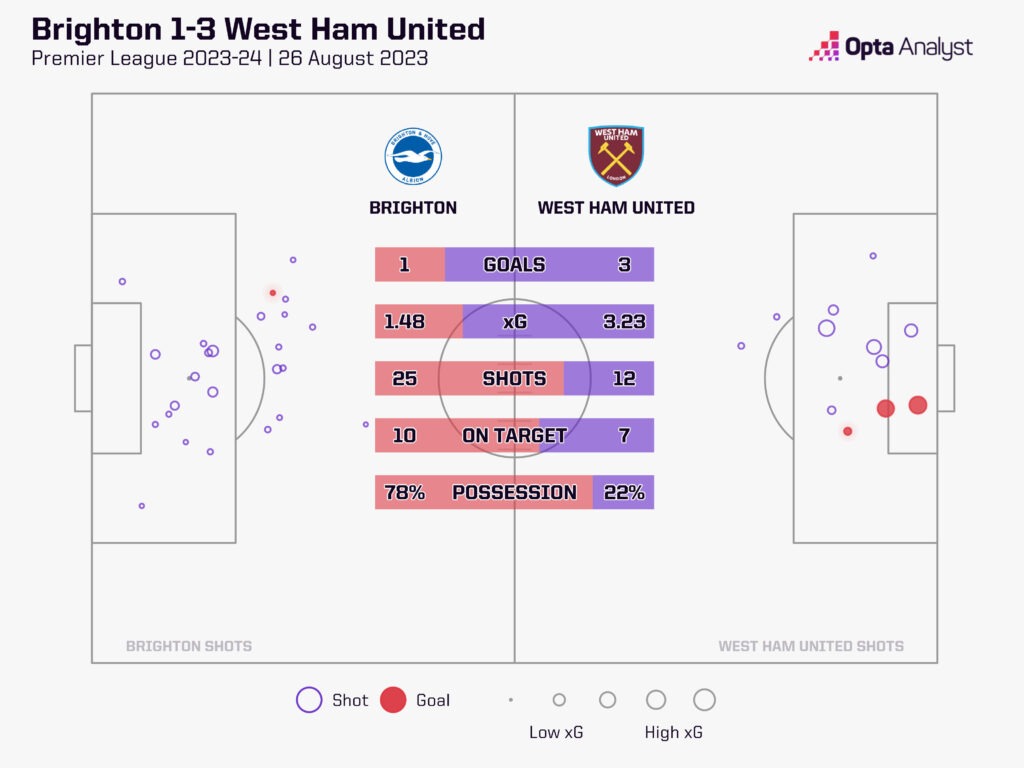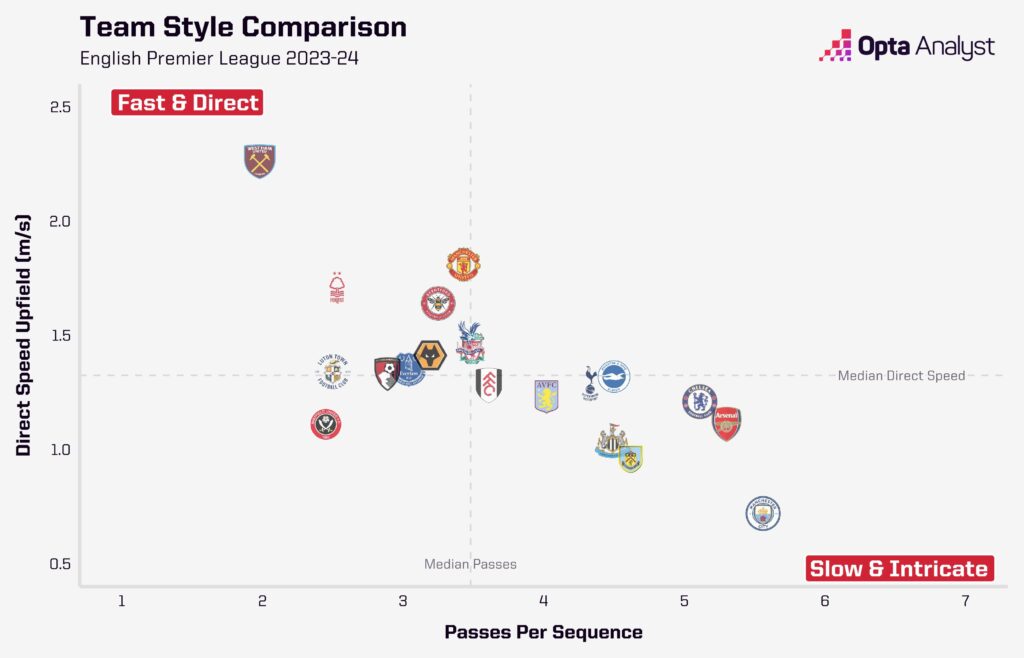In an interview with Alan Shearer for The Athletic last week, Chelsea manager Mauricio Pochettino suggested he preferred the Premier League when tactics were less homogenous.
“When we arrived here, you would have 20 teams in the Premier League and it was difficult to find two or three teams playing in the same kind of style,” he said.
“It was all different. Our [tactic] was to press high and build from the back, and the only other team that tried to play from the back was Liverpool under Brendan Rodgers. We surprised people a little bit with the style, but when Pep (Guardiola) and (Jürgen) Klopp arrived, all the coaches seemed to [also] use this way of playing. Now it’s like all teams try to build from the back, all the teams try to press high all the time. It’s like it was contagious.”
Whether it was indeed more exciting or better back when Pochettino was at Southampton is up for debate, but he is certainly right that there used to be more variety in Premier League tactics. It’s fair to say playing out from the back is now considered the “right” way to play the game, and even in the lower leagues of English football, playing the short game is increasingly common and largely even the norm. Going direct might now be described as a “throwback” or a more “traditional” way of playing, certainly at Premier League level, at least.
What the Chelsea manager isn’t right about, though, is his assertion that “all teams try to build from the back, all teams try to press high all the time.”
There are a few teams that disprove that theory, and West Ham are doing it best.
They are showing with their early-season form that you don’t have to play the Pep or Klopp way to win games in the top flight. It’s early days and they are a long way off proving that their counter-attacking football is a sustainable method with which to challenge at the top end of the table for a full season, but three games in, they are second behind Manchester City, having pulled off successive 3-1 wins against Chelsea and Brighton, two of the strongest teams in the Premier League.

The numbers behind their sensational start to the season are quite remarkable. It hasn’t been backs-to-the-wall defending and smash-and-grab wins, but David Moyes has set his team up to allow their opponents domination of both possession and territory, before striking on the break.
West Ham have averaged just 27.3% possession in their three games so far, the lowest share for any team in the top four flights of English football in 2023-24. Their attacks have started closer to their own goal on average than any other team in the Premier League, at a distance of 35.1 metres up the pitch, while they have both attempted (278) and completed (228) fewer passes per 90 than any other top-flight side. Their pass success rate of 67.6% is the worst in the Premier League, too.
On average, their open-play sequences have lasted just two passes and 5.4 seconds – both are the lowest of all Premier League teams. They have strung together an open-play sequence of 10 passes or more on only four occasions all season, or 1.3 times per game. The team with the second-fewest open-play sequences of 10+ passes is newly-promoted-and-very-much-struggling Luton Town, and even they are managing an average of three per game as they try to find their feet in the Premier League for the first time. Luton have lost both of their games so far, conceding seven goals and scoring just one.
A look at West Ham’s zones-of-control graphic for the season so far paints quite the picture: they are only dominating (having 55% or more of the touches in a zone) in two of the 30 zones we split the pitch into, and both of those zones are inside their own penalty area. The third zone inside the West Ham area is deemed ‘contested’ which means their opposing players are having a similar number of touches in this zone of the West Ham penalty box to Moyes’ own team.
It doesn’t sound or look much like “the right way” to play the game, but their results suggest they aren’t doing it the wrong way, either.
West Ham are second in the Premier League with seven points from a possible nine, the third-highest total of goals (seven) and goal difference (+4) bettered only by City (+5), the only team above them in the table.
The contrast in the styles of play of the league’s two leading sides could not be greater. As our team styles comparison graphic shows, City sit at the ‘slow and intricate’ end of the scale, and West Ham are right at the other end as the most ‘fast and direct’ team. Every other team sits somewhere in between.

Generally speaking, the teams who are stylistically closer to City are the more successful ones – or at least the teams that we’d expect to be higher up the table come May.
We are only three games into the season, and there is every chance that Moyes adapts how his team plays against different opponents – something we could see when they face fellow possession-haters Luton on Friday night – but their games so far also include a trip to Bournemouth, who they were more than happy to leave in control of the ball. West Ham had just 37.1% possession at the Vitality Stadium. And based on results so far, there doesn’t seem much reason for them to change their approach.
They have barely played out from the back at all. Two-thirds (66.7%) of West Ham’s goal-kicks have been kicked directly into the opposition half (22 of 33), the second-highest proportion in the league behind Sheffield United (78.8%). Only Sheffield United and Crystal Palace have seen a smaller proportion of their goal-kicks passed to a teammate inside their own penalty area than West Ham (21.2%).
And yet, Moyes’ side are getting into good goalscoring positions pretty regularly, and they are doing so by playing direct. As the above graphic shows, when they do get the ball, they are moving it up the pitch quicker than any other Premier League team, at 2.3 metres per second.
We can use our ‘directness’ metric to see how direct each team’s approach has been. Defined as ‘the percentage of the distance a team covers that is upfield’, fairly unsurprisingly West Ham are well clear at the top, with 46% of their distance covered upfield. Only two other Premier League teams’ directness is above 30%.
The result has been chances worth 6.1 expected goals, the seventh-highest tally in the Premier League. They are responsible for two of the five goals scored from counter-attacks in the Premier League this season. Set-pieces have also played their part – as you might expect from a Moyes team, and particularly one that has just added James Ward-Prowse – with 1.4 xG from dead balls and one actual goal, but that is hardly the bedrock of their success. It is, however, another route to goal that West Ham will certainly look to make the most of this season.
It might not be a style of play that many would call the most attractive, and it might not be enough to sustain anything like the form with which West Ham have started the season, but it is proving exceptionally effective for now. Any team that thinks they are dominating a game against Moyes’ side because they have seen more of the ball would do well to avoid complacency. Before they know it, West Ham will be up the other end of the pitch.
They are choosing to do things their own way. Whether it’s ‘right’ or ‘wrong’ doesn’t really matter; West Ham are flying high and rightly enjoying themselves up near the top of the table. The Premier League is a better place for it.
Enjoy this? Subscribe to our mailing list to receive exclusive weekly content. And follow us on Twitter too.
